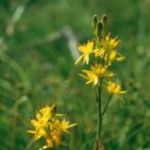| Common Name: |
Anemarrhena asphodeloides |
| Botanical Name: |
Anemarrhena asphodeloides |
| Genus: |
Anemarrhena |
| Family: |
Asphodelaceae |
| Native Location: |
Japan and N China |
| Cultivation: |
Moist soil in partial shade. |
| Propagation: |
By division in spring. |
| Harvest: |
Rhizomes are lifted in autumn and dried for use in decoctions. |
| Height: |
45cm-1m (1½-3ft) |
| :Width |
Indefinite |
| Hardiness: |
Z3-6 |
| Parts Used: |
Rhizomes (zhi mu) |
| Properties: |
A bitter, mucilaginous, tonic herb that has expectorant and diuretic effects, lowers fever, reduces blood sugar levels, and clears bacterial and fungal infections. |
| Medicinal Uses: |
Internally for high fever in infectious diseases, tuberculosis, chronic bronchitis, and urinary problems. Not given to patients with diarrhea. Excess may cause a sudden drop in blood pressure. Externally as a mouthwash for mouth ulcers. Therapeutic action is slightly altered by cooking with wine or salt. |
| Bibliography: |
Encylopedia of Herbs by Deni Brown Copyright ©: 1995, 2001 Dorling Kindersley Limited pp 121
|

